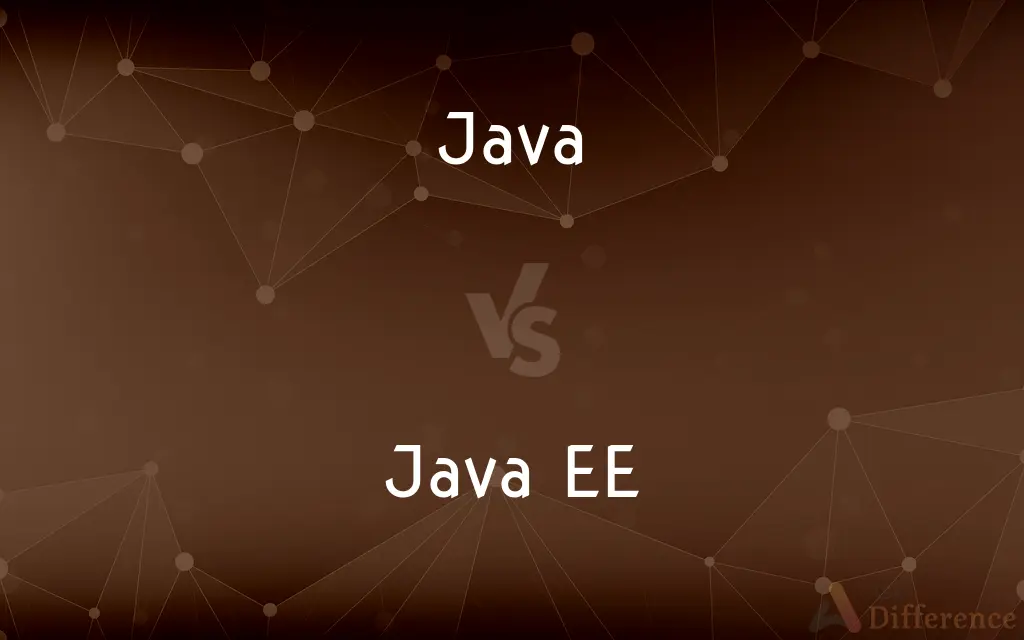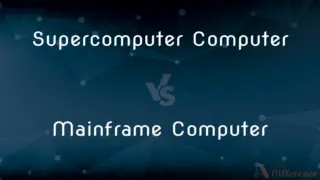Java vs. Java EE — What's the Difference?
By Tayyaba Rehman — Published on January 1, 2024
Java is a programming language and computing platform, while Java EE (Enterprise Edition) is a specification for building enterprise-level applications on Java.

Difference Between Java and Java EE
Table of Contents
ADVERTISEMENT
Key Differences
Java is a versatile programming language that can be used for applications ranging from desktop to server environments. Java EE, on the other hand, is a set of specifications that extends Java, providing additional functionality for developing large-scale, multi-tiered, scalable, reliable, and secure network applications.
Java focuses on providing a robust, secure, and portable platform for application development. Java EE takes this a step further by offering APIs and runtime environments for developing and running enterprise-specific applications such as banking and e-commerce systems.
While Java is mainly concerned with coding applications, Java EE includes a platform for the enterprise environment, which supports Java programs with a large suite of libraries. Java EE provides a standard for enterprise features like distributed computing and web services.
Java can be used to develop standalone applications or applets, whereas Java EE is used for developing and deploying web-based enterprise applications. Java EE applications are typically layered applications, logically separated into components for the front-end, business logic, and data access.
In summary, Java is the foundation, and Java EE is a larger framework that builds upon Java, providing additional libraries and services designed for enterprise-level applications. Java EE is specifically designed to meet the needs of enterprise applications which require a broader set of functionalities than standard Java.
ADVERTISEMENT
Comparison Chart
Purpose
General-purpose programming language.
Enterprise-level application development.
Scope
Standalone applications or applets.
Web-based, scalable enterprise applications.
Libraries
Standard libraries for core features.
Extensive libraries for enterprise features.
Framework and APIs
Basic set of APIs.
Advanced set of APIs for enterprise solutions.
Usage
Desktop, mobile, embedded systems.
Large-scale, multi-tiered, secure network applications.
Compare with Definitions
Java
Known for its Write Once, Run Anywhere (WORA) capability, meaning compiled Java code can run on all platforms that support Java.
Java's WORA feature simplifies software distribution.
Java EE
Includes specifications for advanced features like distributed computing and fault-tolerant systems.
Our enterprise solution uses Java EE for its distributed computing capabilities.
Java
Is a popular choice for building secure, robust, and high-performance applications.
We chose Java for our server-side application to ensure robustness.
Java EE
Supports various enterprise technologies like Servlets, JavaServer Pages (JSP), and Enterprise JavaBeans (EJB).
We developed the server-side code using EJBs as part of the Java EE ecosystem.
Java
It includes a Java Virtual Machine (JVM) which allows it to execute programs on different hardware platforms.
The Java Virtual Machine ensures consistent performance across different systems.
Java EE
Offers a comprehensive platform for enterprise-level services such as web services, component models, and communication APIs.
Java EE's extensive suite of services was utilized to facilitate seamless communication between distributed systems.
Java
Has a wide range of use from consumer electronics to large-scale enterprise systems.
Java is used in a multitude of devices, from IoT sensors to data centers.
Java EE
Aims to reduce complexity and improve application portability in enterprise environments.
Java EE's standard interfaces simplify the integration of third-party components.
Java
A high-level, class-based, object-oriented programming language designed for portability and cross-platform application development.
The Android app was developed using Java.
Java EE
An enterprise-centric version of Java that provides APIs for developing large-scale, multi-tiered, scalable, and secure network applications.
The corporate web application was built on Java EE to handle extensive user load.
Java
Brewed coffee.
Java
A blend of coffee imported from the island of Java.
Java
Coffee in general.
Java
A dance popular in France in the early 20th century.
Java
One of the islands of the Malay Archipelago belonging to the Netherlands.
Java
Java coffee, a kind of coffee brought from Java.
Java
An object-oriented computer programming language, derived largely from C++, used widely for design and display of web pages on the world-wide web. It is an interpreted language, and has been suggested as a platform-independent code to allow execution of the same progam under multiple operating systems without recompiling. The language is still (1997) under active development, and is evolving.
Java
An island in Indonesia south of Borneo; one of the world's most densely populated regions
Java
A beverage consisting of an infusion of ground coffee beans;
He ordered a cup of coffee
Java
A simple platform-independent object-oriented programming language used for writing applets that are downloaded from the World Wide Web by a client and run on the client's machine
Common Curiosities
How does Java EE enhance Java?
Java EE adds enterprise-oriented libraries and APIs to the standard Java, facilitating the development of large-scale applications.
What is the Java Virtual Machine (JVM)?
JVM is a part of Java that enables it to run on any platform without modification to the code.
What is Java primarily used for?
Java is used for building platform-independent applications and is popular in mobile, desktop, and server environments.
What are the key features of Java?
Key features of Java include portability, object-oriented structure, security, and robust memory management.
Can I use Java EE for desktop applications?
While possible, Java EE is primarily designed for server-side and enterprise-level applications, not desktop applications.
Can Java EE applications run without Java?
No, Java EE applications require Java as they are built on top of Java's core platform.
Do I need to learn Java before Java EE?
Yes, understanding Java is essential before moving on to Java EE, as it is built upon Java.
What makes Java EE suitable for enterprises?
Java EE provides a robust framework with APIs for building large-scale, multi-tiered, scalable, and secure network applications suitable for enterprises.
What are Servlets and JSP?
Servlets and JSP are technologies in Java EE for developing dynamic web content.
What does WORA mean in Java?
WORA stands for "Write Once, Run Anywhere," referring to Java's capability to run on any device with a JVM.
How are Java and Java EE distributed?
Java is distributed as JDK (Java Development Kit) for developers, while Java EE is provided as part of an enterprise edition server.
Is Java suitable for web applications?
Yes, Java can be used for web applications, but Java EE provides more specialized tools and frameworks for web-based enterprise applications.
What are Enterprise JavaBeans (EJB)?
EJB is a component of Java EE that encapsulates business logic, making it reusable and simplifying enterprise application development.
Is Java EE open source?
Yes, Java EE and its associated technologies are open-source.
Are there any alternatives to Java EE?
Yes, there are alternatives like Spring Framework, which also provide comprehensive support for enterprise application development.
Share Your Discovery

Previous Comparison
Soft Ground vs. Firm Ground
Next Comparison
Supercomputer Computer vs. Mainframe ComputerAuthor Spotlight
Written by
Tayyaba RehmanTayyaba Rehman is a distinguished writer, currently serving as a primary contributor to askdifference.com. As a researcher in semantics and etymology, Tayyaba's passion for the complexity of languages and their distinctions has found a perfect home on the platform. Tayyaba delves into the intricacies of language, distinguishing between commonly confused words and phrases, thereby providing clarity for readers worldwide.














































